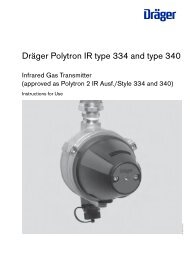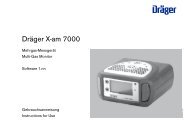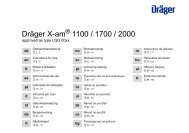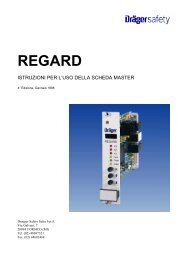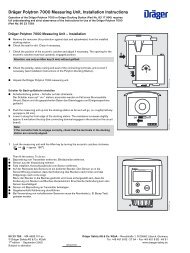Dräger Polytron 3000 - ancb.it
Dräger Polytron 3000 - ancb.it
Dräger Polytron 3000 - ancb.it
Create successful ePaper yourself
Turn your PDF publications into a flip-book with our unique Google optimized e-Paper software.
Maintenance<br />
Un<strong>it</strong> calibration<br />
Caution:<br />
— When the transm<strong>it</strong>ter is installed in Ex areas zone 22 or Class II, Div. 1 & 2,<br />
Group E, F, G the opening of the housing (required for calibration) must not<br />
be done when connected to power (power must be turned off or the area<br />
has to be declassified). Explosion hazard!<br />
— Ensure that the sensor is warmed up before <strong>it</strong> is calibrated. See the sensor data<br />
sheet for the warming-up time.<br />
— Only the zero point is checked if an oxygen sensor has been f<strong>it</strong>ted. The zero point<br />
of an oxygen sensor does not require calibration.<br />
— The transm<strong>it</strong>ter can be calibrated by the operator on s<strong>it</strong>e.<br />
— For cr<strong>it</strong>ical applications, the calibration intervals should be defined in accordance<br />
w<strong>it</strong>h the recommendations in EN 50073 1) , EN45544-4 2) and national regulations.<br />
Note the calibration sequence!<br />
● First check the zero point and correct <strong>it</strong> necessary, Immediately after this, check<br />
the sens<strong>it</strong>iv<strong>it</strong>y and adjust <strong>it</strong> as necessary.<br />
— Never calibrate the sens<strong>it</strong>iv<strong>it</strong>y before calibrating the zero point.<br />
— Zero gas and test gas: see the information in the sensor data sheet.<br />
Caution:<br />
Test gas must not be inhaled. Risk to health! Care must be taken about the<br />
risks which can arise when using test gas; hazard instructions and safety advice<br />
must be observed.<br />
For details, see appropriate DIN Safety Data Sheets.<br />
<strong>Polytron</strong><br />
●<br />
Open the front cover of the service port w<strong>it</strong>h an Allen key by turning anticlockwise<br />
(approx. 60 o ). The maintenance sw<strong>it</strong>ch and potentiometers for calibration are now<br />
revealed.<br />
Attention!<br />
Use only a 5 mm Allen key w<strong>it</strong>hout a ball head.<br />
Note:<br />
The <strong>Dräger</strong> <strong>Polytron</strong> <strong>3000</strong> does not support the storage of calibration data<br />
in the sensor data base.<br />
01323785_1.eps<br />
Measuring / maintenance mode<br />
1 Maintenance sw<strong>it</strong>ch w<strong>it</strong>h two pos<strong>it</strong>ions.<br />
2 Measuring mode pos<strong>it</strong>ion (left-hand pos<strong>it</strong>ion) – measured values are relayed to<br />
the analogue output.<br />
3 Maintenance mode pos<strong>it</strong>ion (right-hand pos<strong>it</strong>ion) – a maintenance signal (3.4 mA<br />
±0.2 mA constant) is relayed to the analogue output and prevents alarms being<br />
triggered.<br />
1)<br />
EN 50073 – Guidelines for selection, installation, use and maintenance of devices for the<br />
detection and measurement of flammable gases and oxygen.<br />
2) EN 45544-4 – Electrical devices for the direct detection and direct concentration measurement<br />
of toxic gases and vapours – Part 4: Guidelines for selection, installation, use and<br />
maintenance.<br />
1<br />
2<br />
3<br />
01423758_1.eps<br />
14



